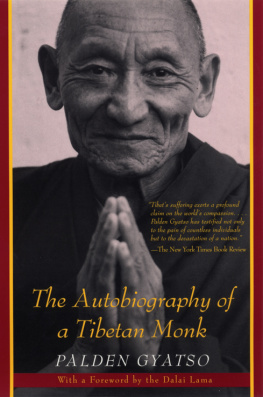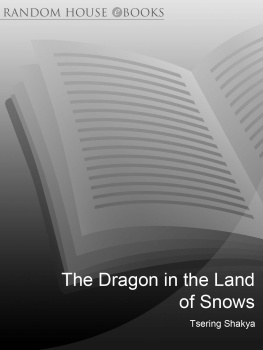Sign up to receive weekly Tibetan Dharma teachings and special offers from Shambhala Publications.

Or visit us online to sign up at shambhala.com/eshambhala.
Coming Home to Tibet
A Memoir of Love, Loss, and Belonging
T SERING W ANGMO D HOMPA


Shambhala
BOULDER
2016
Shambhala Publications, Inc.
4720 Walnut Street
Boulder, Colorado 80301
www.shambhala.com
2013 by Tsering Wangmo Dhompa
First published in Hamish Hamilton by Penguin Books India 2013
All rights reserved. No part of this book may be reproduced in any form or by any means, electronic or mechanical, including photocopying, recording, or by any information storage and retrieval system, without permission in writing from the publisher.
LIBRARY OF CONGRESS CATALOGING-IN-PUBLICATION DATA
Dhompa, Tsering Wangmo.
Coming home to Tibet: a memoir of love, loss, and belonging / Tsering Wangmo Dhompa.First Shambhala edition.
pages cm
First published in Hamish Hamilton by Penguin Books India, 2013Title page verso.
eISBN: 978-0-8348-4010-2
ISBN 978-1-61180-329-7 (paperback: acid-free paper)
1. Dhompa, Tsering Wangmo.
2. Dhompa, Tsering WangmoTravelChinaTibet Autonomous Region.
3. Tibet Autonomous Region (China)Description and travel. 4. Dhompa, Tsering WangmoFamily. 5. Mothers and daughters. 6. MothersDeath. 7. HomePsychological aspects. 8. Place attachment. 9. Tibet Autonomous Region (China)Biography. 10. Tibet Autonomous Region (China)Social life and customs. I. Title.
DS 786. D 56 2016 951.505092dc23 [B] 2015027116
To Tsering Choden Dhompa
Beloved Mother

My mother was still settling into the role of being wife to a chieftain of a nomadic clan in 1959. She accepted the new name, Tashi Dolkar, given to her by her in-laws. She parted her hair on the unfamiliar side. She stopped wearing trousers under her dress. She was eighteen.
It did not alarm her at first when she heard the Chinese army had encircled all strategic Tibetan towns and cities. Nomads in her village professed to witnessing two suns, or two moons, or a barren sky. Trees collapsed. Rivers grew tumid. Then came news that entire villages of central Tibet were fleeing for Nepal or India.
My mother packed valuables. She followed her husband out of her home on a cold night. They set out for an unknown country. A hint of summer held grass upright.
She disciplined her memory to give up counting her losses. She gave her suffering one name: exile.
All of her exiled life she waited to return home. She spoke of exile as something that would be expunged over time. When this is over, we can go home.
She waited from year to year. She carried a hope that if we waited long enough, this would end.
This is not a simple story.

Every summer my mother culled images of flowers from her childhood. There were the ones with white lollipop heads that grew with cheeky profusion impeding her stride; there were the lissom blue beauties, translucent and shapely as a glass bottle, who fooled her into thinking they were half-reptilian; and the waxy and purple bull-dog-faced flowers she could never uproot because they hugged the ground so tenaciously.
Did they look like this? I would ask her, holding up buttercups or primroses that grew in the yards of neighbors who had larger families and correspondingly, more plants.
The flowers in Tibet were more beautiful, according to my mother.
What about those? I would point to stocky bushes of wild daisies that grew alongside paths in Dharamshala where we lived until I was twelve years old.
The flowers in Tibet were always taller, more fragrant and vivid. Her descriptions, imprecise but unchanging from year to year, had led me to an inevitable acceptance that her past was unequaled by our present lives. She would tell me of the knee-deep fields of purple, red, and whiteplants never named or pointed out to us during our years in India and Nepalthat over time served to create an idea of her fatherland, phayul, as a riotous garden. I pictured her wilderness paradise of flowers by comparing them not to the marigolds, daisies, and bluebells I crushed with my fingers, but to the shapes of household artifacts around me: lollipop, broom, bottle. Disparate objects that surrendered to and influenced the idea, space, and hope of a more abundant and happy place.
When there are just two of you, you appropriate images from each other and inhabit one tongue until the stories that compose your two worlds become interchangeable. It was so for my mother and me.
We would return to Tibet someday, mother said when she came home from a long day in the office and was too tired to cook dinner for us, or when she labored under the weight of grocery bags in the summer heat. I lived with the notion that, as refugees, our life in exile was temporary. It was easy to accept that idea in our two-room house in Dharamshala where everything we owned fit into the four aluminium steel suitcases under our two twin cots.
Phayul: the word was a constant reminder that everything wonderful that eluded us in exile waited for us in Tibet. Existing without proof of photographs or contact, this Tibet was our real home.

A new years morning is indistinguishable from other mornings if you are traveling through small villages and towns on the Grand Trunk Road leading to the city of Chandigarh. Early morning fog hovers above wheat fields. One or two light bulbs cast a brumous glow into the spaces between modest brick houses visible as silhouettes. My mother and her three friends had hired a jeep and a driver to take them from Delhi to Dharamshala. The sun rose lazily on the first day of January 1994.
A man emptying his bowels in a field witnessed the collision on the highway. A truck is a powerful beast, he would comment later to a police officer. He saw a jeep spin like a dizzy house sparrow. The mans peaceful morning ritual had been shattered by the intrusion of death.
A police officer who was among the first to reach the scene of the accident told me that my mother had looked intact to him. I did not think she would die, he said to me on my visit to the Karnal police station two months after the accident.
The doctor who had tended to her had known otherwise. He was reluctant to speak to me or to elaborate on the postmortem documents.
I asked if she had suffered.
What does it matter? She is dead, he replied. How can I remember? People die every day.
I asked again if she had suffered. He handed me five documents with Unknown scribbled untidily across the top of each page. He could not tell me which of the pages contained my mothers information. I had glanced at the descriptions of the unnamed dead knowing I would find clues to the person I loved most.
Unknown: Female. Age: Unknown. Maroon jacket. Brown dress. No bra or underwear.
My mother did not return home during her lifetime.
CHAPTER ONE

Next page












